The Boston Massachusetts Temple
of the Church of Jesus Christ of Latter-Day Saints
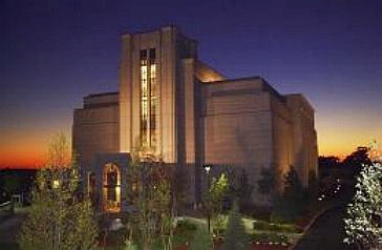

The Church originally planned to build a very large 94,000 square foot temple in Boston with a dramatic six-spire design. However, many future neighbors of the temple opposed the idea of a temple in their neighborhood at all, so the Church reduced the size of the temple several times and made several other attempts to compromise. Finally the temple's size was reduced to 69,000 square feet, cut the number of spires from six to one, and moved one third of the building underground, all to reduce its impact on the neighborhood.
After finally winning a building permit, the Church broke ground, only to face a lawsuit by three neighbors stating that the law that allowed the Church to build such a large building in a residential area was unconstitutional because it gave schools and religious organizations an unfair advantage. The Church decided that it had compromised enough and the case went to court. After winning the first decision the Church began construction, taking extraordinary lengths to minimize the effect the construction had on the lives of the neighbors. Every time a jackhammer was used a soundproof box was placed over it. Earthen berms were raised around the site to hide it and prevent dust from blowing out of the site. a water truck kept the ground constantly wet, also to minimize dust. The first court decision has been appealed and the final decision may have to wait until it can be heard by the U.S. Supreme Court.
The court battle has taken on a significance far beyond that of our Church's right to build a single temple. The law in question, the Dover Amendment, is similar to several state laws that give Church's and other public institutions, like schools, exemption from zoning laws so that the right of freedom of religion is not infringed by city governments. By challenging the law, the opponents to the temple's construction have called into question the right of any Church in any state to build any building that does not conform to local zoning laws. Nearly every religion and church in the Boston area have supported the Mormon Church in this case, several even giving money and legal advise.
Despite the continuing court case, the Church was confident enough in its position to go ahead with the construction. However, another lawsuit halted construction on the Temple's steeple, which also violates local zoning laws, but was approved by the city council under the same law. The first judge to hear the case ruled that while the spire was significant symbolically, it was not necessary for the full religious functioning of the temple, and therefore could not be built. The Church has appealed this ruling, stating that the steeple is a definite and important part of the temple, it is a symbol of reaching up to heaven and humanity's divine nature, therefore an expression of religious devotion, and to prevent it's construction an infringement of freedom of religion. Once again nearly every other church in the area has given its support to the Mormon Church and its position.
In fact, the Church has received overwhelming support from area churches. During the fight to get approval to build the building local ministers helped correct false information circulated about the Church, even letting local Church leaders speak in their congregations. Partly due to their efforts, and the Church's dramatic efforts to accommodate neighborhood concerns, those living close to the Temple, with the exemption of those few supporting the lawsuit, are now very supportive of the temple and proud that it is located in their neighborhood. The Church estimated that 80% of the population of Belmont attended the open house, and some even verbally apologized for their previous opposition.
The temple was announced on 30 September 1995.
Ground was broken and construction begun on 13 June 1997.
The cornerstone was laid and the temple dedicated on 1 October 2000.
There are 4 Sealing rooms and 4 Ordinance rooms in the 69,000 square foot temple.
The spire is not built yet.
The Boston Temple serves stakes in Maine, New Hampshire, Vermont, Rhode Island, Massachusetts and New York.
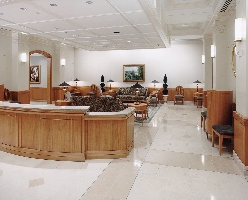 The Waiting Area. Source: Open House Brochure. |
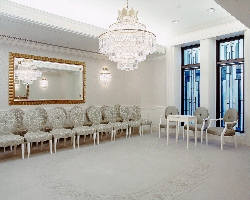 One of the two Sealing Rooms. Source: Open House Brochure. |
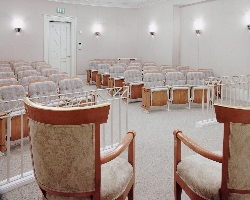 One of the two Endowment Rooms. Source: Open House Brochure. |
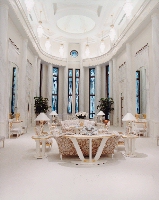 The Celestial Room. Source: Open House Brochure. |
 Previous Temple. |

|
 Back to The Chronological List. |
 Back to The Temple Guide. |
 Back to The Alphabetical List. |